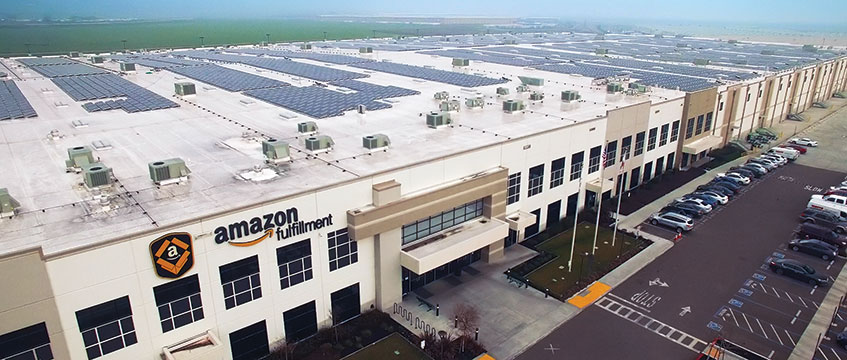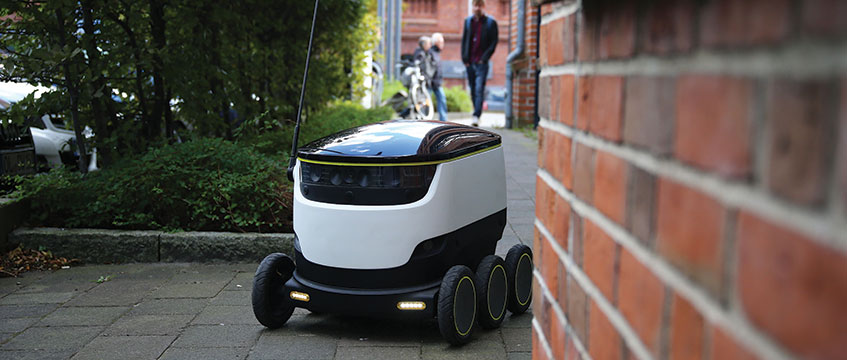Distribution warehouses are going high-tech. Increasing use of automation and robots mean less manual labour, more high-tech jobs.
This will influence the size, shape and use of space in a number of ways – and how industrial space is serviced, see “Power play” below. Potentially, fewer staff means less amenity space. The flip side of that is that occupiers will need to attract and retain staff with tech skills so there may be more emphasis on the kind and style of amenities provided.
More automation, says Ivan Scott, divisional partner at business pace agency Glenny, also means more dense operations and the potential for higher racking systems allowing for a more efficient use of space.
“Building size and design will change over time as automation becomes more commonplace within the logistics supply chain,” he says.
Ian Worboys, chief executive, P3, is primarily a build-to-suit developer and says the firm is already building taller to accommodate more technological advanced operations.
“Almost all new P3 warehouses now have 12m clear internal height, 2m more than the norm, which provides an increase in storage capacity of up to 20%,” he says.
“This kind of automation does have implications in the construction of warehouses, such as the requirement for the super-flat floors necessary to ensure the ‘robots’ can follow the instructions they are given.”
Building size and design will change over time as automation becomes more commonplace within the logistics supply chain
The outside of the building is changing too. Worboys explains: “We are also seeing the requirement for more docks as the use of AI management systems speeds up turnaround times, enabling the receipt and dispatch of more product and also demand for more smaller doors for rapid local deliveries by vans rather than just large trucks.”
Longer term, John Munday, managing director of Paragon, thinks the way in which goods are delivered could allow for more dense development.
“A 200,000 sq ft warehouse presently may need about 25 loading bays, along with circulation and parking for articulated lorries. If that transport is replaced by drones (even in part) then the site density increases significantly and landowners can achieve greater value from their sites,” he says.
As a footnote, it would be easy to dismiss drone deliveries (see opinion) as there are many hurdles to overcome to make them viable, but you have to factor in how the retail landscape is shifting.
E-commerce of course means goods travelling to consumers – increasingly with less time between click and delivery – rather than the other way around. Needs-based (link to this comment piece as a related article https://www.egi.co.uk/news/how-to-nurture-needs-based-retail/ ) and experiential retail are how some are describing the future of retail – hip trainer retailer Vans has a store in London where you can’t actually buy anything, for example. How will this affect how and where stock is stored and distributed?
Power play
When it comes to tech in the industrial and logistics world, it is very easy to become distracted by robots and automated vehicles, writes Samantha McClary.
But as a logistics landlord or developer, there is one element of the tech world that needs to be firmly on your radar if you want to provide your clients with the best service possible. And while they may not be quite as exciting as Amazon’s Kiva robot or the latest Tesla incarnation from Elon Musk, none of those glitzier bits of tech would work without them.
What is it? Power.
Definitely not exciting, but definitely essential.
“It is the practical and efficient application of tech that helps people perform better,” says SEGRO chief operating officer Andy Gulliford. “It is not really about image in industrial, it is about how that piece of real estate contributes to an occupier’s business. Tech has a role in that.”

P3 chief executive Ian Worboys agrees. He says ensuring a site has enough power to feed the occupiers’ technological demands, both now and in the future, is vital.
“Warehouses need sophisticated systems,” he says. “They need algorithms to predict where demand is going to be so they can be prepared when orders come in. Even standard warehouses have high-tech systems now. You need to make sure you have the power. Power is critical.”
“Life is moving to automation and robotics and to alternatively fuelled vehicles,” adds Gulliford. “We are responding to customer needs on these things right now.
A huge amount of power is needed for the new generation of warehouses. Vast fulfilment centres with hard-working central computers continuously running algorithms so consumers no longer have to wait more than a day for their goods require power; robot arms and carrying bots to collect and package those orders require power; and, increasingly, the methods of transportation to deliver those goods require the same type of power. The demand is so much bigger than even a decade ago.
So for landlords and developers to properly service their clients, they need to properly provide the power.
In March 2017 Amazon announced it was to install solar systems on 50 of its fulfilment centre rooftops worldwide by 2020 to help meet power demands. Some 15 were planned to be completed by the end of the year, generating as much as 41 MW.
Depending on the specific project, time of year and other factors, Amazon believes its solar installations could generate as much as 80% of a fulfilment facility’s annual energy needs.
SEGRO launched the world’s first carbon-neutral warehouse in 2016 in Enfield, Middlesex. The 173,000 sq ft Navigation Park development, reduced its power consumption through being fitted with motion controlled LED lighting and created its own power through the installation of 535 kWp of photovoltaic panels across the three buildings that make up the development.
For P3’s Worboys, this is the future of warehouses. He believes that soon warehouses will be self-sufficient with solar panels on rooftops creating the energy which then gets stored in Tesla battery rooms. Once, of course, the storage issue has been sorted out.
By enabling self-sufficiency, Worboys believes that he can keep operating costs down and provide customers with cheaper warehouses. Cheaper to run, anyway, not necessarily cheaper to rent. He cited a P3 warehouse in Europe, where efficiencies on power has saved some €1m over the past five years.
“Tech has enabled us to look after the customer better,” he says.
However, if a landlord or a developer cannot guarantee a level or regularity of power for today’s warehousing clients, their space will be passed over.
To truly service the tech needs of a client, warehouse providers must invest in sites where power capability is possible and plentiful.
“The future is here,” says Worboys, “Some of the change is scary, and some of it is exciting. All of it presents an opportunity.”
Comment: Logistics and robotics
Bill Page, business space research manager, LGIM Real Assets
The technology advances affecting logistics are significant. This is true for both the hardware which picks, sorts and delivers, and the software which organises and learns.
Across our fund management platform we recognise the importance of occupier engagement. These advances in technology signal to us that the landlord and occupier relationship is more crucial than ever, and that those who can get this right now will reap the rewards when these changes come into play.
There are structural differences driving the pace of change and a clear requirement to improve productivity in the UK.

The tech world is responding. According to CB Insights, tech funding into global supply chains and logistics increased from $921m in 2014 to an estimated $4.2bn in 2016. This significant increase is testament to changing consumer demand. The global parcel delivery market is growing at up to 10% a year and “business to consumer” deliveries comprise more than half. Customer satisfaction is now determined by delivery efficiency.
As a major manager of logistics, LGIM Real Assets has identified the following logistics activities as most susceptible to change and those which could cause the biggest implications for real estate:
■ Sensors and tracking: the falling cost of sensor technology and its ability to harvest previously data is transformational. The key is to maximise utility.
■ Freight and supply chain visibility: Big data means intelligent transportation solutions and predictive maintenance
■ Last mile delivery: Drones, droids and autonomous ground vehicles will all become a part of our world to varying degrees
■ Trucking and regional delivery: Investment has been in software efficiency as well as autonomous trucks, but there is certainly momentum behind the latter
■ Warehousing and picking – Technology’s ability to replace humans is growing. Most important is the software which aids routing and product recognition.
Efficiencies in process and prediction will lower the space requirement per good. This does not mean less space demand – growth in ecommerce should offset any absorption implication.
Picking technology will allow for higher warehouses. As vehicles become smarter, yard requirements may fall but flexibility for multiple docking (and electric charging points) will become more important. Fleet management will become more technical.
Over the next decade it is feasible that there will be autonomous motorway driving, with a driver taking control for smaller roads.
With more tech comes more expertise – adjacencies to towns with a strong engineering and software background will become more important. There are social implications to this and the receptiveness of local governance to “low job growth” will matter.
At LGIM Real Assets we believe that the future will be less about motorway connectivity and cheap labour and more about proximity to customers and maximising last-mile delivery efficiencies. Generally we are expecting to see considerable growth in occupational demand in the 20,000-100,000 sq ft size bracket from operators related to e-commerce and last-mile deliveries.
With such change there will be risk, particularly around obsolescence. However, disruption delineates performance and investors who partner with operators and get space and place decisions right will be well placed to enjoy superior investor performance.











